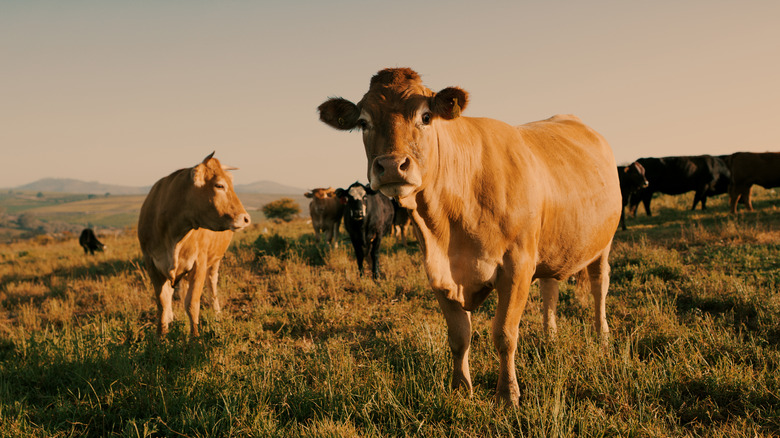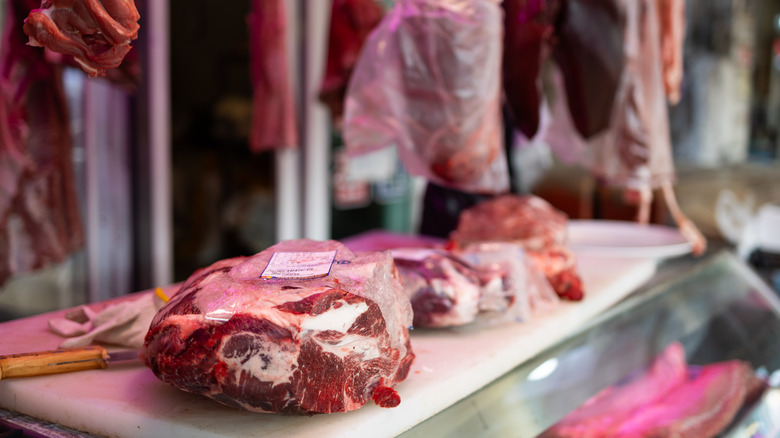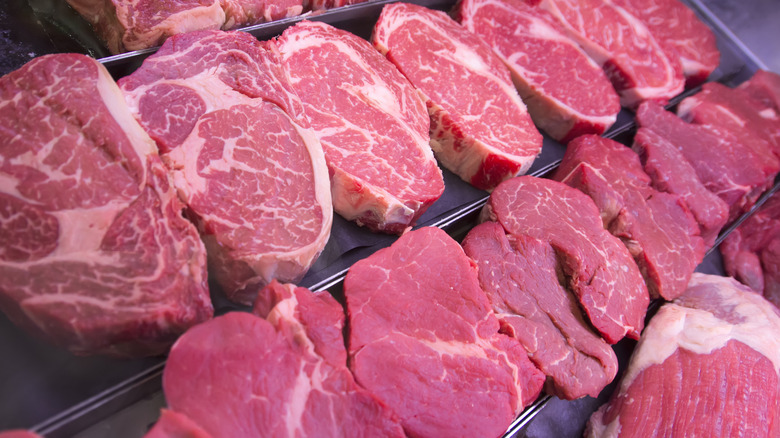The Flavor Difference Between Grass-Fed And Grain-Fed Beef
Most of the beef you see in stores comes from cows that chow on either grains or grass. Grain-fed beef, which is cheaper and more common, means the cows eat stuff like soy or corn. It's not their natural diet, but it helps them pack on the pounds fast, leading to hefty meat in no time. This method is popular in countries like the U.S., where farming is highly industrialized (only 4% of the beef produced in the U.S. is grass-fed, according to the South Dakota State University.) On the other hand, grass-fed cattle graze on grass and other forages, a diet more aligned with their natural instincts. While this approach is considered more traditional and ethical, it often results in a higher price tag for grass-fed beef at the supermarket. Grass-fed meat is more commonly produced in countries like Australia, where 97% of their cattle are raised in pastures according to The NEFF Kitchen.
But the differences between grain-fed and grass-fed beef go beyond just ethics and pricing. It turns out that "you are what you eat" goes for cows too, and what the animal eats has a very noticeable effect on how it tastes once pan-seared or herb-roasted!
How the diet of the cattle can impact your beef's taste
Because grains are more nutrient-dense than grass, the meat from grain-fed cattle tends to have prominent white streaks of fat and marbling. This marbling is what gives beef its rich flavor and tender texture, making grain-fed meat quite tasty despite its reputation for being "unnaturally" fed. Furthermore, since the USDA grades beef cuts based on its marbling, grain-fed beef often makes up a significant portion of premium meat selections like USDA Prime and Choice in supermarkets.
In contrast, grass-fed beef tends to be leaner with less fat, resulting in less impressive marbling due to grass providing less energy than grains. According to a study in the Food Science of Animal Resources journal, grass-fed Australian beef has about half as much crude fat as grain-fed American beef. As a result, grass-fed beef is typically less juicy and firmer in texture, with a distinct gamey, earthy taste from the greens in their diet.
This doesn't mean the flavor of grass-fed is inferior to grain-fed, though. For example, Angus beef raised on high-quality pastures often has access to abundant grass in vast grazing areas, meaning they don't need to trod far for food. This lack of exercise can lead to fat accumulation, resulting in beautiful marbling in grass-fed Angus beef that rivals grain-fed counterparts.
How about grass-finished or grain-finished beef?
All cattle, whether grass-fed or grain-fed, initially begin their lives grazing on grass. However, for grain-fed cattle, once they reach a certain age (about 7 to 9 months-old,) they're moved to large feedlots where they're fed grains instead.
Now, here's where things can get a bit tricky. A cow may primarily graze on grass for most of its life but then may be switched to a different diet shortly before being slaughtered. This process is known as "finishing." A beef that undergoes this transition is called grain-finished beef. In some places like Australia, cattle can be fed grains for a period, such as up to 89 days, yet still be labeled as "grass-fed." In such cases, you end up with what's known as "grass-fed, grain-finished" beef, which should have a flavor and marbling similar to grain-fed beef.
On the other hand, grass-fed, grass-finished cattle are those that exclusively graze on grass and forage throughout their entire lives. This type of beef is considered the "purest" since it's what a natural cow's diet would be like in the wild. However, this type of meat can be very lean and chewy as a result, so try not to overcook your grass-fed beef!


